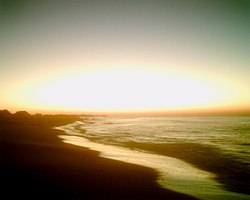Okaloosa Island is an area on Santa Rosa Island, Florida, United States.
Okaloosa Island, Florida | |
|---|---|
 |
An 875-acre (354 ha) parcel of Santa Rosa Island with 3 miles (4.8 km) of Gulf frontage was conveyed to Okaloosa County on July 8, 1950, in an informal ceremony at the county courthouse in Crestview. The county paid the federal government $4,000 to complete the transaction, which was the result of the efforts of Congressman Bob Sikes.[1] This area had been known as Tower Beach with the establishment of an amusement park, boardwalk and hotel from the mid-1930s. Tower Beach, with a board walk, casino, restaurant and concession stands, and operated by Thomas E. Brooks, of the same family for whom the Brooks Bridge is named, was largely destroyed by fire on Saturday, March 7, 1942. Wartime priorities precluded its reconstruction.[2]
The last of three county-owned buildings on Okaloosa Island was torn down on May 31, 1995. The buildings had originally housed the Okaloosa Island Authority and more recently the Okaloosa County Council on Aging. The 1.3-acre (0.53 ha) tract on the north side of Santa Rosa Boulevard was sold.[3]
References
[edit]- ^ Fort Walton, Florida, "Island Tract Turned Over To Okaloosa - Formal Transfer Completed With $4,000 Payment", Playground News, Thursday 13 July 1950, Volume 5, Number 24, page 1.
- ^ Crestview, Florida, "Amusement Area Of Tower Beach Is Destroyed By Fire", Okaloosa News-Journal, Friday 13 March 1942, Volume 28, Number 8, page 1.
- ^ Fort Walton Beach, Florida, "Today in Local History", Northwest Florida Daily News, Sunday 31 May 2015, Volume 69, Number 120, page B4.
Well, that’s interesting to know that Psilotum nudum are known as whisk ferns. Psilotum nudum is the commoner species of the two. While the P. flaccidum is a rare species and is found in the tropical islands. Both the species are usually epiphytic in habit and grow upon tree ferns. These species may also be terrestrial and grow in humus or in the crevices of the rocks.
View the detailed Guide of Psilotum nudum: Detailed Study Of Psilotum Nudum (Whisk Fern), Classification, Anatomy, Reproduction